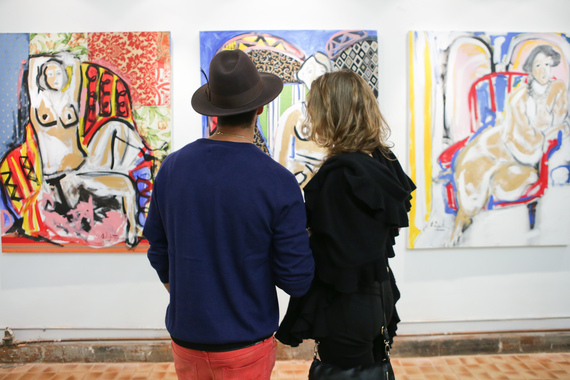Presently, I have a solo exhibition showing at Lab Art Gallery in Los Angeles, "A Nod to Matisse".
My intention was to pay a great homage to the Maestro. A native Spaniard myself, I was raised in Mallorca where there exists a shimmering Mediterranean glow which has inspired artists for centuries. My passion for color, light, food, wine, music, and dance come from my heritage and can be seen, celebrated, in these canvases. I visited the Alhambra on numerous occasions and have seen Matisse's signature in its guest book. I have been touched by the overwhelming beauty of that palace and it carries its history in my Spanish blood. It is no wonder I feel a great closeness to the work of Matisse and his Spanish experiences!
Matisse visited Spain in the winter of 1910, suffering from depression and was so taken by the Moorish influences that they gave him inspiration to paint in Morocco. At the time of his journey he was so morbidly depressed that he hadn't picked up a paintbrush in a year. The work he had created in 1908-9 had been widely rejected and the death of his father shortly after sent the artist to an even darker place. Before arriving in Granada, he first stayed in Seville with friends. He spent his days in the flamenco schools and his evenings in drawing classes, confessing Seville inspired him to work. With his spirits somewhat lifted, Matisse ventured to Granada to see the Alhambra Palace on December 9, 1910.
The Alhambra is a wonder and it was originally constructed as a fortress in 889 AD and converted in the 12th century into a royal palace that housed the last Muslim emirs in Spain. While the palace serves as a testimony to the aesthetic and intellectual wealth of Islamic art and architecture, its Spanish setting serves an important role in terms of aesthetic and cultural importance. With light in Southern Spain positively radiant, it fills the chambers and courtyards of the palace. The Moorish poets called the Alhambra "a pearl among emeralds," referring to the color of the building set against the surrounding forest of Andalusia. When converting the fortress into a palace, the architects and artisans of the Nasrid dynasty moved away from the Byzantine influences associated with their crafts and tended to incorporate instead, motifs and styles that had developed over the last 8 centuries of Muslim rule in Spain, where Christian, Jewish, and Muslim artistic practices had influenced each other. The Alhambra represents and exudes the richness of Spain's historically diverse population as well as the unique qualities of its most treasured cultural traditions. As Washington Irving poetically described,
Of course, the palace, unlike any example of Islamic art Matisse had seen, is a massive three-dimensional structure. It is extremely ornate, adorned entirely with Arabic inscriptions manipulated into sacred geometrical patterns and set into arabesques (those beautiful linear patterns of interlacing foliage). Painted tiles cover the walls star shaped windows diffuse that beautiful Mediterranean light into glittering beams that bounce off the floors and fountains of the interiors. Various reflecting pools act as mirrors to the perfect geometries of the architecture, creating an infinity effect throughout visual space of the palace. And yet, despite the intensity and variety of the ornamentation in the Alhambra, there is a certain unshakable unity to the aesthetic here and an unmistakably peaceful spaciousness created by its architecture.
When Matisse first saw the palace, he was mesmerized. He declared in a letter to his wife, Amelie (whom he wrote daily!) "The Alhambra is a marvel. I have felt intense emotion here." He saw the structure, as he had seen the Islamic decorative arts, as a metaphor for harmony. He became inspired by the artistic techniques employed by the Spanish-Muslim world in rendering this seductive tranquility. While he had always endeavored to create fantasy, balance, and spaciousness in his own canvases, the palace gave Matisse a fresh perspective on how to achieve his goal.
Matisse was so exhilarated by the experience that at last he began to paint again. He was so eager to start he couldn't even wait for his wife to send him his materials. After three days in Granada studying the Alhambra, he ran back Seville where he borrowed paints and brushes from a friend. At this moment, Matisse began a new level of artistic exploration. He committed himself to the search of compositional harmony and creation of space within the flatness of the canvas and it is apparent in all of his subsequent work. More obviously, we see the influence of his trip to Spain in certain markers and figures in subsequent canvases. For example, we see Matisse increasingly incorporate dark, black, curving lines derived from the calligraphic work in Islamic art. The artist also focused increasingly on rendering the patterns of tapestries, shawls, and textiles purchased on this trip in his paintings. Even more specifically, certain pieces of furniture, pictured in post-cards Matisse himself purchased at the site can be found in dozens of canvases.
When looking at Matisse's, odalisques, or paintings of "Oriental" women (the models were all actually European), the viewer can imagine he/she is glancing into the most intimate chambers of the Alhambra Palace. Each odalisque is set in a kind of "Oriental theater," in which Matisse intensifies the exotic intimacy of the scene by enclosing his figures within the space of the painting. Notably, there are no windows in these scenes, no open doors, no other people. The figures seem to dream privately, yet with the anticipation of the viewer's gaze, within the colorful arabesque rooms to which they are confined. The figures do not announce themselves, rather, these spaces, the backgrounds of the images, reveal them to us, as if drawing back a curtain.
Inspired by this connection, I was set out to explore some of the same formal concerns and imaginative, colorful sensuality found in the work of the master. A nod to Matisse reimagines some of Matisse's most celebrated odalisques.


